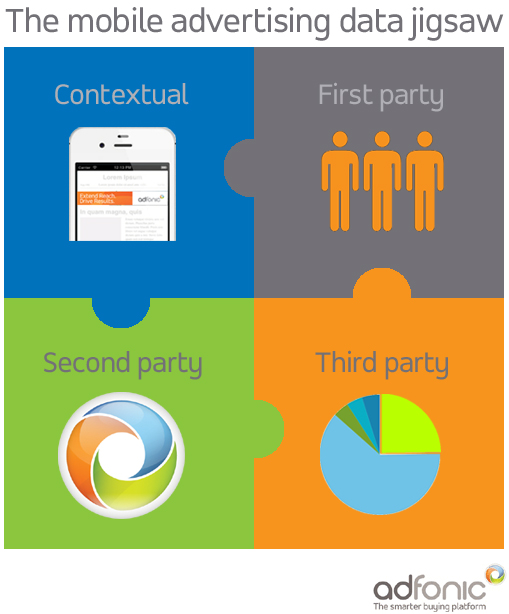Remember when you thought a megabyte was big? Megabytes beget terabytes, terabytes beget petabytes, petabytes beget exabytes. Today the digiverse holds around 2.7 zettabytes, where one ZB equals a billion terabytes. And about 90% of all the data ever created was generated in the past two years – a trend that looks set to continue.
So data is big, and getting bigger. While this is a huge opportunity for you as digital marketers, you need to familiarise yourselves with it if you want to realise this opportunity. You need to know how it fits together so you can make it work to your benefit.
At Adfonic we deal with vast amounts of data because we’ve invested heavily in programmatic buying, in particular mobile Real-time Bidding (RTB). This applies smart algorithms to big data to match the right mobile ads to the right mobile inventory, through a more effective, efficient mechanism (you can read more about mobile RTB from my co-founder, Wes Biggs).
To do this, we employ four key types of data that fit together, enabling us to zero in on our client’s goals and unlock real mobile advertising value, as shown below.

Increasingly we need to discuss this data with clients simply so that they understand the service we provide. So consider this your Mobile Advertising Data 101. In five minutes you’ll know more about mobile advertising data than the marketer sitting next to you – or, more importantly, those working for your competitors.
Contextual data
Let’s start with publishers, who have inventory to sell on mobile sites or apps. They provide data about this inventory which, because it’s the context in which ads will appear, is called contextual data.
Typical contextual data identifies the mobile site or app, and possibly a specific placement within it. It also describes the vertical category of the app and the size of the ad slot, as well as information about the user’s location (country-level or more specific) and device, from which we can determine platform, OS version and other capabilities.
We use this contextual data for yes/no targeting options when we set up campaigns. As such, it forms the building blocks for constructing campaigns because it’s a yes/no question whether we should serve a particular campaign to, say, an iPhone, in Russia, on the Angry Birds app.
But contextual data can also help us predict future results based on what we’ve seen in the past, given all these contextual clues. For example, we might know that a certain ad performs best on a particular type of app, and better still when served to specific ‘hot’ combinations such as a Samsung Galaxy device in the UK, for example. This helps us when we’re advising marketing clients from the outset, and also helps our algorithms progressively improve as they learn more about what works.
First-party data
First-party data is from the advertiser, and characterises the target audience the advertiser wants to reach. The greater the match between contextual and first-party data, the more relevant – and therefore effective – the ad. An example of first-party data could be the specific users’ device IDs so that the ads reach the right people.
In the near future we expect to see more nuance around first-party data that will enable more advanced retargeting. Advertisers could identify audiences for offers within campaigns, for example presenting an ad for the two-door model of a car rather than a four-door model. They could also specify higher bids for certain audiences given their past interactions, being prepared to invest more heavily in users they think are most likely to convert.
Second-party data
This is where companies like Adfonic come in. We process billions of mobile ad transactions every week, yielding an extremely rich, broad and deep source of data that we manage, mine and use to gain insights.
Through our interactions with exchanges and users we can start to form impressions of audiences, for example whether they are male or female, their age, their propensity to click on travel ads and so on.
By applying this data to the campaigns we run, we can get smarter and really add value. When we combine what the publisher thinks characterises the inventory, with what the advertiser thinks is the right audience, we can augment this with our second-party data and zero in on what actually works.
Third-party data
This is data bought in from external companies which further describes audiences.
So, an advertiser might want to introduce data that targets users by segments, with demographic details and behavioural hints that point towards intent to purchase a specific type of item. This complements the publisher’s contextual data, the advertiser’s first-party data, and the ad platform’s second-party data, to improve targeting.
Bringing the pieces together
At Adfonic, every impression we manage today is transacted via programmatic buying, which encompasses all the above. The more contextual data we have, the more we know about a publisher’s inventory. The more first-party data, the more ‘hooks’ we can use to match a mobile ad to that inventory. Throughout the lifetime of a campaign, we generate second-party data that helps maximise the value to the advertiser and publisher alike. And we can lay third-party on top of all this to sharpen our focus.
Whatever type of digital marketer you are, from the data fiend who insists on analysis, analysis, analysis to the animal that relies on its marketing instincts or somewhere in between, you should at least recognise these terms. Because the data is not going to get any smaller any time soon.





